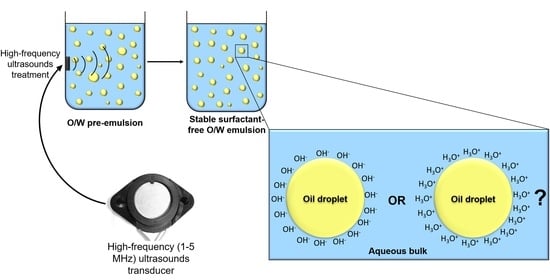Review of High-Frequency Ultrasounds Emulsification Methods and Oil/Water Interfacial Organization in Absence of any Kind of Stabilizer
Abstract
1. Introduction
2. Emulsification and Stabilization Processes
2.1. Main Emulsification Processes
2.1.1. High-Energy Emulsification Methods
High-Speed Homogenization
Low-Frequency Ultrasounds
High-Pressure Homogenization
Microfluidization
2.1.2. Low-Energy Emulsification Methods
Membrane and Microchannel Emulsifications
Other Low-Energy Emulsification Methods
2.2. Specific Case of High-Frequency Ultrasounds Process
2.2.1. Definition and Generalities
2.2.2. Emulsification and Stabilization by High-Frequency Ultrasounds
2.2.3. High-Frequency Ultrasounds Emulsification Uses
2.2.4. High-Frequency Ultrasounds Emulsification Drawbacks
2.3. Conclusion on Emulsification Processes
3. Emulsifier-Free Oil/Water Interface Organization
3.1. First Hypothesis: Hydroxide Ions Adsorption at Interface
3.1.1. Macroscopic Measurements
3.1.2. Spectroscopic and Simulation Studies on Interfaces
3.1.3. Other Origins of the Negative Charge
3.2. Second Hypothesis: Hydronium Ions Adsorption at Interface
3.3. Other Hypotaheses
3.3.1. No Charge at Interface
3.3.2. H3O+ and OH− Presence
3.4. Conclusion on Interfacial Organization
4. Conclusions
Author Contributions
Funding
Data Availability Statement
Conflicts of Interest
References
- Binks, B.P. Emulsions—Recent Advances in Understanding. In Modern Aspects of Emulsion Science; The Royal Society of Chemistry: London, UK, 1998; pp. 1–55. ISBN 978-0-85404-439-9. [Google Scholar]
- Sakai, T. Surfactant-Free Emulsions. Curr. Opin. Colloid Interface Sci. 2008, 13, 228–235. [Google Scholar] [CrossRef]
- Hou, W.; Xu, J. Surfactant-Free Microemulsions. Curr. Opin. Colloid Interface Sci. 2016, 25, 67–74. [Google Scholar] [CrossRef]
- Callender, S.P.; Mathews, J.A.; Kobernyk, K.; Wettig, S.D. Microemulsion Utility in Pharmaceuticals: Implications for Multi-Drug Delivery. Int. J. Pharm. 2017, 526, 425–442. [Google Scholar] [CrossRef] [PubMed]
- Abdulredha, M.M.; Siti Aslina, H.; Luqman, C.A. Overview on Petroleum Emulsions, Formation, Influence and Demulsification Treatment Techniques. Arab. J. Chem. 2020, 13, 3403–3428. [Google Scholar] [CrossRef]
- Gupta, A.; Burak Eral, H.; Alan Hatton, T.; Doyle, P.S. Nanoemulsions: Formation, Properties and Applications. Soft Matter 2016, 12, 2826–2841. [Google Scholar] [CrossRef] [PubMed]
- Petrowski, G.E. Emulsion Stability and Its Relation to Foods. Adv. Food Res. 1976, 22, 309–359. [Google Scholar] [CrossRef]
- Piorkowski, D.T.; McClements, D.J. Beverage Emulsions: Recent Developments in Formulation, Production, and Applications. Food Hydrocoll. 2014, 42, 5–41. [Google Scholar] [CrossRef]
- Buddin, M.M.H.S.; Ahmad, A.L.; Khalil, A.T.A.; Puasa, S.W. A Review of Demulsification Technique and Mechanism for Emulsion Liquid Membrane Applications. J. Dispers. Sci. Technol. 2020, 43, 910–927. [Google Scholar] [CrossRef]
- Wiącek, A.; Chibowski, E. Zeta Potential, Effective Diameter and Multimodal Size Distribution in Oil/Water Emulsion. Colloids Surf. A Physicochem. Eng. Asp. 1999, 159, 253–261. [Google Scholar] [CrossRef]
- Singh, R.D.; Kapila, S.; Ganesan, N.G.; Rangarajan, V. A Review on Green Nanoemulsions for Cosmetic Applications with Special Emphasis on Microbial Surfactants as Impending Emulsifying Agents. J. Surfactants Deterg. 2022, 25, 303–319. [Google Scholar] [CrossRef]
- De, S.; Malik, S.; Ghosh, A.; Saha, R.; Saha, B. A Review on Natural Surfactants. RSC Adv. 2015, 5, 65757–65767. [Google Scholar] [CrossRef]
- Seweryn, A. Interactions between Surfactants and the Skin–Theory and Practice. Adv. Colloid Interface Sci. 2018, 256, 242–255. [Google Scholar] [CrossRef] [PubMed]
- Shah, R.; Kolanos, R.; DiNovi, M.J.; Mattia, A.; Kaneko, K.J. Dietary Exposures for the Safety Assessment of Seven Emulsifiers Commonly Added to Foods in the United States and Implications for Safety. Food Addit. Contam. Part A 2017, 34, 905–917. [Google Scholar] [CrossRef] [PubMed]
- Cao, Y.; Liu, H.; Qin, N.; Ren, X.; Zhu, B.; Xia, X. Impact of Food Additives on the Composition and Function of Gut Microbiota: A Review. Trends Food Sci. Technol. 2020, 99, 295–310. [Google Scholar] [CrossRef]
- Chevalier, Y.; Bolzinger, M.-A. Emulsions Stabilized with Solid Nanoparticles: Pickering Emulsions. Colloids Surf. A Physicochem. Eng. Asp. 2013, 439, 23–34. [Google Scholar] [CrossRef]
- Calabrese, V.; Courtenay, J.C.; Edler, K.J.; Scott, J.L. Pickering Emulsions Stabilized by Naturally Derived or Biodegradable Particles. Curr. Opin. Green Sustain. Chem. 2018, 12, 83–90. [Google Scholar] [CrossRef]
- Perrin, L.; Gillet, G.; Gressin, L.; Desobry, S. Interest of Pickering Emulsions for Sustainable Micro/Nanocellulose in Food and Cosmetic Applications. Polymers 2020, 12, 2385. [Google Scholar] [CrossRef] [PubMed]
- Nakabayashi, K.; Amemiya, F.; Fuchigami, T.; Machida, K.; Takeda, S.; Tamamitsu, K.; Atobe, M. Highly Clear and Transparent Nanoemulsion Preparation under Surfactant-Free Conditions Using Tandem Acoustic Emulsification. Chem. Commun. 2011, 47, 5765–5767. [Google Scholar] [CrossRef]
- Kaci, M.; Meziani, S.; Arab-Tehrany, E.; Gillet, G.; Desjardins-Lavisse, I.; Desobry, S. Emulsification by High Frequency Ultrasound Using Piezoelectric Transducer: Formation and Stability of Emulsifier Free Emulsion. Ultrason. Sonochem. 2014, 21, 1010–1017. [Google Scholar] [CrossRef]
- Dickinson, W. The Effect of PH upon the Electrophoretic Mobility of Emulsions of Certain Hydrocarbons and Aliphatic Halides. Trans. Faraday Soc. 1941, 37, 140–148. [Google Scholar] [CrossRef]
- Reddy, S.R.; Fogler, H.S. Emulsion Stability of Acoustically Formed Emulsions. J. Phys. Chem. 1980, 84, 1570–1575. [Google Scholar] [CrossRef]
- Marinova, K.G.; Alargova, R.G.; Denkov, N.D.; Velev, O.D.; Petsev, D.N.; Ivanov, I.B.; Borwankar, R.P. Charging of Oil−Water Interfaces Due to Spontaneous Adsorption of Hydroxyl Ions. Langmuir 1996, 12, 2045–2051. [Google Scholar] [CrossRef]
- Beattie, J.K.; Djerdjev, A.M. The Pristine Oil/Water Interface: Surfactant-Free Hydroxide-Charged Emulsions. Angew. Chem. Int. Ed. 2004, 43, 3568–3571. [Google Scholar] [CrossRef] [PubMed]
- Beattie, J.K.; Djerdjev, A.M.; Warr, G.G. The Surface of Neat Water Is Basic. Faraday Discuss. 2008, 141, 31–39. [Google Scholar] [CrossRef]
- Fang, H.; Wu, W.; Sang, Y.; Chen, S.; Zhu, X.; Zhang, L.; Niu, Y.; Gan, W. Evidence of the Adsorption of Hydroxide Ion at Hexadecane/Water Interface from Second Harmonic Generation Study. RSC Adv. 2015, 5, 23578–23585. [Google Scholar] [CrossRef]
- Petersen, P.B.; Saykally, R.J. Evidence for an Enhanced Hydronium Concentration at the Liquid Water Surface. J. Phys. Chem. B 2005, 109, 7976–7980. [Google Scholar] [CrossRef]
- Vácha, R.; Buch, V.; Milet, A.; Devlin, J.P.; Jungwirth, P. Autoionization at the Surface of Neat Water: Is the Top Layer PH Neutral, Basic, or Acidic? Phys. Chem. Chem. Phys. 2007, 9, 4736–4747. [Google Scholar] [CrossRef]
- Winter, B.; Faubel, M.; Vácha, R.; Jungwirth, P. Behavior of Hydroxide at the Water/Vapor Interface. Chem. Phys. Lett. 2009, 474, 241–247. [Google Scholar] [CrossRef]
- Mamatkulov, S.I.; Allolio, C.; Netz, R.R.; Bonthuis, D.J. Orientation-Induced Adsorption of Hydrated Protons at the Air–Water Interface. Angew. Chem. Int. Ed. 2017, 56, 15846–15851. [Google Scholar] [CrossRef]
- Walstra, P. Principles of Emulsion Formation. Chem. Eng. Sci. 1993, 48, 333–349. [Google Scholar] [CrossRef]
- McClements, D.J.; Rao, J. Food-Grade Nanoemulsions: Formulation, Fabrication, Properties, Performance, Biological Fate, and Potential Toxicity. Crit. Rev. Food Sci. Nutr. 2011, 51, 285–330. [Google Scholar] [CrossRef]
- Islam, F.; Saeed, F.; Afzaal, M.; Hussain, M.; Ikram, A.; Khalid, M. Food Grade Nanoemulsions: Promising Delivery Systems for Functional Ingredients. J. Food Sci. Technol. 2022. [Google Scholar] [CrossRef]
- Yukuyama, M.N.; Ghisleni, D.D.M.; Pinto, T.J.A.; Bou-Chacra, N.A. Nanoemulsion: Process selection and application in cosmetics—A review. Int. J. Cosmet. Sci. 2016, 38, 13–24. [Google Scholar] [CrossRef] [PubMed]
- Espitia, P.J.P.; Fuenmayor, C.A.; Otoni, C.G. Nanoemulsions: Synthesis, Characterization, and Application in Bio-Based Active Food Packaging. Compr. Rev. Food Sci. Food Saf. 2019, 18, 264–285. [Google Scholar] [CrossRef] [PubMed]
- Azmi, N.A.N.; Elgharbawy, A.A.; Motlagh, S.R.; Samsudin, N.; Salleh, H.M. Nanoemulsions: Factory for Food, Pharmaceutical and Cosmetics. Processes 2019, 7, 617. [Google Scholar] [CrossRef]
- Wang, Z.; Neves, M.A.; Isoda, H.; Nakajima, M. Preparation and Characterization of Micro/Nano-Emulsions Containing Functional Food Components. Jpn. J. Food Eng. 2015, 16, 263–276. [Google Scholar] [CrossRef]
- Jasmina, H.; Džana, O.; Alisa, E.; Edina, V.; Ognjenka, R. Preparation of Nanoemulsions by High-Energy and Low-Energy Emulsification Methods. In CMBEBIH 2017; Springer: Berlin/Heidelberg, Germany, 2017; pp. 317–322. [Google Scholar]
- Urban, K.; Wagner, G.; Schaffner, D.; Röglin, D.; Ulrich, J. Rotor-Stator and Disc Systems for Emulsification Processes. Chem. Eng. Technol. 2006, 29, 24–31. [Google Scholar] [CrossRef]
- Rayner, M. Scales and Forces in Emulsification. In Engineering Aspects of Food Emulsification and Homogenisation; Taylor & Francis: Abingdon, UK, 2015; pp. 3–32. [Google Scholar]
- Bhargava, N.; Mor, R.S.; Kumar, K.; Sharanagat, V.S. Advances in Application of Ultrasound in Food Processing: A Review. Ultrason. Sonochem. 2021, 70, 105293. [Google Scholar] [CrossRef]
- Zhou, L.; Zhang, J.; Xing, L.; Zhang, W. Applications and Effects of Ultrasound Assisted Emulsification in the Production of Food Emulsions: A Review. Trends Food Sci. Technol. 2021, 110, 493–512. [Google Scholar] [CrossRef]
- Stepišnik Perdih, T.; Zupanc, M.; Dular, M. Revision of the Mechanisms behind Oil-Water (O/W) Emulsion Preparation by Ultrasound and Cavitation. Ultrason. Sonochem. 2019, 51, 298–304. [Google Scholar] [CrossRef]
- Yadav, K.S.; Kale, K. High Pressure Homogenizer in Pharmaceuticals: Understanding Its Critical Processing Parameters and Applications. J. Pharm. Innov. 2020, 15, 690–701. [Google Scholar] [CrossRef]
- Jafari, S.M.; He, Y.; Bhandari, B. Production of Sub-Micron Emulsions by Ultrasound and Microfluidization Techniques. J. Food Eng. 2007, 82, 478–488. [Google Scholar] [CrossRef]
- Leal-Calderon, F.; Schmitt, V.; Bibette, J. Emulsion Science: Basic Principles; Springer: Berlin/Heidelberg, Germany, 2007. [Google Scholar]
- Vladisavljević, G.T. Preparation of Microemulsions and Nanoemulsions by Membrane Emulsification. Colloids Surf. A Physicochem. Eng. Asp. 2019, 579, 123709. [Google Scholar] [CrossRef]
- Liu, Y.; Li, Y.; Hensel, A.; Brandner, J.J.; Zhang, K.; Du, X.; Yang, Y. A Review on Emulsification via Microfluidic Processes. Front. Chem. Sci. Eng. 2020, 14, 350–364. [Google Scholar] [CrossRef]
- Vitale, S.A.; Katz, J.L. Liquid Droplet Dispersions Formed by Homogeneous Liquid- Liquid Nucleation: “The Ouzo Effect”. Langmuir 2003, 19, 4105–4110. [Google Scholar] [CrossRef]
- Izadifar, Z.; Babyn, P.; Chapman, D. Ultrasound Cavitation/Microbubble Detection and Medical Applications. J. Med. Biol. Eng. 2019, 39, 259–276. [Google Scholar] [CrossRef]
- Ehsani, M.; Zhu, N.; Doan, H.; Lohi, A.; Abdelrasoul, A. In-Situ Synchrotron X-Ray Imaging of Ultrasound (US)-Generated Bubbles: Influence of US Frequency on Microbubble Cavitation for Membrane Fouling Remediation. Ultrason. Sonochem. 2021, 77, 105697. [Google Scholar] [CrossRef]
- Kamogawa, K.; Okudaira, G.; Matsumoto, M.; Sakai, T.; Sakai, H.; Abe, M. Preparation of Oleic Acid/Water Emulsions in Surfactant-Free Condition by Sequential Processing Using Midsonic-Megasonic Waves. Langmuir 2004, 20, 2043–2047. [Google Scholar] [CrossRef]
- Nakabayashi, K.; Fuchigami, T.; Atobe, M. Tandem Acoustic Emulsion, an Effective Tool for the Electrosynthesis of Highly Transparent and Conductive Polymer Films. Electrochim. Acta 2013, 110, 593–598. [Google Scholar] [CrossRef]
- Nakabayashi, K.; Fuchigami, T.; Atobe, M. Templated Electrochemical Synthesis of Conducting Polymer Nanowires from Corresponding Monomer Nanoemulsions Prepared by Tandem Acoustic Emulsification. RSC Adv. 2014, 4, 22938–22940. [Google Scholar] [CrossRef]
- Yasuda, K.; Nakayama, S.; Asakura, Y. Characteristics of Nanoemulsion Prepared by Tandem Acoustic Emulsification at a High Frequency. J. Chem. Eng. Jpn. 2012, 45, 734–736. [Google Scholar] [CrossRef]
- Nakabayashi, K.; Kojima, M.; Inagi, S.; Hirai, Y.; Atobe, M. Size-Controlled Synthesis of Polymer Nanoparticles with Tandem Acoustic Emulsification Followed by Soap-Free Emulsion Polymerization. ACS Macro Lett. 2013, 2, 482–484. [Google Scholar] [CrossRef] [PubMed]
- Nakabayashi, K.; Yanagi, H.; Atobe, M. Preparation of W/O Nanoemulsion Using Tandem Acoustic Emulsification and Its Novel Utilization as a Medium for Phase-Transfer Catalytic Reaction. RSC Adv. 2014, 4, 57608–57610. [Google Scholar] [CrossRef]
- Hirai, Y.; Koshino, M.; Matsumura, Y.; Atobe, M. Synthesis of Spherical Polymer Nanoparticles Reflecting Size of Monomer Droplets Formed by Tandem Acoustic Emulsification. Chem. Lett. 2015, 44, 1584–1585. [Google Scholar] [CrossRef]
- Koshino, M.; Shiraishi, Y.; Atobe, M. Size-Controlled Synthesis of Polymer Hollow Nanoparticles Using Emulsion Templates Prepared by Tandem Acoustic Emulsification. Ultrason. Sonochem. 2019, 54, 250–255. [Google Scholar] [CrossRef] [PubMed]
- Mikami, R.; Nakamura, Y.; Shida, N.; Atobe, M. Anodic Substitution Reaction of Carbamates in a Flow Microreactor Using a Stable Emulsion Solution. React. Chem. Eng. 2021, 6, 2024–2028. [Google Scholar] [CrossRef]
- Kobayashi, D.; Hiwatashi, R.; Asakura, Y.; Matsumoto, H.; Shimada, Y.; Otake, K.; Shono, A. Effects of Operational Conditions on Preparation of Oil in Water Emulsion Using Ultrasound. Phys. Procedia 2015, 70, 1043–1047. [Google Scholar] [CrossRef]
- Kaci, M.; Arab-Tehrany, E.; Dostert, G.; Desjardins, I.; Velot, E.; Desobry, S. Efficiency of Emulsifier-Free Emulsions and Emulsions Containing Rapeseed Lecithin as Delivery Systems for Vectorization and Release of Coenzyme Q10: Physico-Chemical Properties and in Vitro Evaluation. Colloids Surf. B Biointerfaces 2016, 147, 142–150. [Google Scholar] [CrossRef]
- Kaci, M.; Arab-Tehrany, E.; Desjardins, I.; Banon-Desobry, S.; Desobry, S. Emulsifier Free Emulsion: Comparative Study between a New High Frequency Ultrasound Process and Standard Emulsification Processes. J. Food Eng. 2017, 194, 109–118. [Google Scholar] [CrossRef]
- Kichou, H.; Dancik, Y.; Eklouh-Molinier, C.; Huang, N.; Soucé, M.; Gressin, L.; Gillet, G.; Chourpa, I.; Munnier, E.; Bonnier, F. Highlighting the Efficiency of Ultrasound-Based Emulsifier-Free Emulsions to Penetrate Reconstructed Human Skin. Int. J. Cosmet. Sci. 2022, 44, 262–270. [Google Scholar] [CrossRef]
- Miyaji, A.; Kohno, M.; Inoue, Y.; Baba, T. Hydroxyl Radical Generation by Dissociation of Water Molecules during 1.65 MHz Frequency Ultrasound Irradiation under Aerobic Conditions. Biochem. Biophys. Res. Commun. 2017, 483, 178–182. [Google Scholar] [CrossRef] [PubMed]
- Matsumura, Y.; Iwasawa, A.; Kobayashi, T.; Kamachi, T.; Ozawa, T.; Kohno, M. Detection of High-Frequency Ultrasound-Induced Singlet Oxygen by the ESR Spin-Trapping Method. Chem. Lett. 2013, 42, 1291–1293. [Google Scholar] [CrossRef]
- Niki, E. Lipid Peroxidation and Its Inhibition: Overview and Perspectives. J. Oleo Sci. 2001, 50, 313–320. [Google Scholar] [CrossRef]
- Khanum, R.; Thevanayagam, H. Lipid Peroxidation: Its Effects on the Formulation and Use of Pharmaceutical Emulsions. Asian J. Pharm. Sci. 2017, 12, 401–411. [Google Scholar] [CrossRef] [PubMed]
- Ito, J.; Komuro, M.; Parida, I.S.; Shimizu, N.; Kato, S.; Meguro, Y.; Ogura, Y.; Kuwahara, S.; Miyazawa, T.; Nakagawa, K. Evaluation of Lipid Oxidation Mechanisms in Beverages and Cosmetics via Analysis of Lipid Hydroperoxide Isomers. Sci. Rep. 2019, 9, 7387. [Google Scholar] [CrossRef] [PubMed]
- Pangu, G.D.; Feke, D.L. Kinetics of Ultrasonically Induced Coalescence within Oil/Water Emulsions: Modeling and Experimental Studies. Chem. Eng. Sci. 2009, 64, 1445–1454. [Google Scholar] [CrossRef]
- Juliano, P.; Kutter, A.; Cheng, L.J.; Swiergon, P.; Mawson, R.; Augustin, M.A. Enhanced Creaming of Milk Fat Globules in Milk Emulsions by the Application of Ultrasound and Detection by Means of Optical Methods. Ultrason. Sonochem. 2011, 18, 963–973. [Google Scholar] [CrossRef]
- Leong, T.; Johansson, L.; Juliano, P.; Mawson, R.; McArthur, S.; Manasseh, R. Design Parameters for the Separation of Fat from Natural Whole Milk in an Ultrasonic Litre-Scale Vessel. Ultrason. Sonochem. 2014, 21, 1289–1298. [Google Scholar] [CrossRef]
- Kurup, G.G.; Adhikari, B.; Zisu, B. Application of High-Frequency Ultrasound Standing Waves for the Recovery of Lipids from High-Fat Dairy Effluent. Ultrason. Sonochem. 2020, 63, 104944. [Google Scholar] [CrossRef]
- Mettu, S.; Yao, S.; Sun, Q.; Lawson, S.R.; Scales, P.J.; Martin, G.J.; Ashokkumar, M. Effect of Bulk Viscosity and Emulsion Droplet Size on the Separation Efficiency of Model Mineral Oil-in-Water (O/W) Emulsions under Ultrasonic Standing Wave Fields: A Theoretical and Experimental Investigation. Ind. Eng. Chem. Res. 2020, 59, 7901–7912. [Google Scholar] [CrossRef]
- Leibacher, I.; Reichert, P.; Dual, J. Microfluidic Droplet Handling by Bulk Acoustic Wave (BAW) Acoustophoresis. Lab Chip 2015, 15, 2896–2905. [Google Scholar] [CrossRef] [PubMed]
- McClements, D.J. Interfacial properties and their characterization. In Food Emulsions: Principles, Practices, and Techniques, 2nd ed.; CRC Press: Boca Raton, FL, USA, 2004. [Google Scholar]
- Creux, P.; Lachaise, J.; Graciaa, A.; Beattie, J.K.; Djerdjev, A.M. Strong Specific Hydroxide Ion Binding at the Pristine Oil/Water and Air/Water Interfaces. J. Phys. Chem. B 2009, 113, 14146–14150. [Google Scholar] [CrossRef] [PubMed]
- Beattie, J.K. The Intrinsic Charge on Hydrophobic Microfluidic Substrates. Lab Chip 2006, 6, 1409. [Google Scholar] [CrossRef] [PubMed]
- Lützenkirchen, J.; Preočanin, T.; Kallay, N. A Macroscopic Water Structure Based Model for Describing Charging Phenomena at Inert Hydrophobic Surfaces in Aqueous Electrolyte Solutions. Phys. Chem. Chem. Phys. 2008, 10, 4946–4955. [Google Scholar] [CrossRef] [PubMed]
- Quincke, G. Ueber Die Fortführung Materieller Theilchen Durch Strömende Elektricität. Ann. Phys. 1861, 189, 513–598. [Google Scholar] [CrossRef]
- Carruthers, J.C. The Electrophoresis of Certain Hydrocarbons and Their Simple Derivatives as a Function of PH. Trans. Faraday Soc. 1938, 34, 300–307. [Google Scholar] [CrossRef]
- Beattie, J.K.; Djerdjev, A.M.; Franks, G.V.; Warr, G.G. Dipolar Anions Are Not Preferentially Attracted to the Oil/Water Interface. J. Phys. Chem. B 2005, 109, 15675–15676. [Google Scholar] [CrossRef]
- Franks, G.V.; Djerdjev, A.M.; Beattie, J.K. Absence of Specific Cation or Anion Effects at Low Salt Concentrations on the Charge at the Oil/Water Interface. Langmuir 2005, 21, 8670–8674. [Google Scholar] [CrossRef]
- Stachurski, J.; MichaŁek, M. The Effect of the ζ Potential on the Stability of a Non-Polar Oil-in-Water Emulsion. J. Colloid Interface Sci. 1996, 184, 433–436. [Google Scholar] [CrossRef]
- Carpenter, A.P.; Tran, E.; Altman, R.M.; Richmond, G.L. Formation and Surface-Stabilizing Contributions to Bare Nanoemulsions Created with Negligible Surface Charge. Proc. Natl. Acad. Sci. USA 2019, 116, 9214–9219. [Google Scholar] [CrossRef]
- Roger, K.; Cabane, B. Why Are Hydrophobic/Water Interfaces Negatively Charged? Angew. Chem. Int. Ed. 2012, 51, 5625–5628. [Google Scholar] [CrossRef] [PubMed]
- Gan, W.; Wu, W.; Yang, F.; Hu, D.; Fang, H.; Lan, Z.; Yuan, Q. The Behavior of Hydroxide and Hydronium Ions at the Hexadecane–Water Interface Studied with Second Harmonic Generation and Zeta Potential Measurements. Soft Matter 2017, 13, 7962–7968. [Google Scholar] [CrossRef] [PubMed]
- Tian, C.S.; Shen, Y.R. Structure and Charging of Hydrophobic Material/Water Interfaces Studied by Phase-Sensitive Sum-Frequency Vibrational Spectroscopy. Proc. Natl. Acad. Sci. USA 2009, 106, 15148–15153. [Google Scholar] [CrossRef] [PubMed]
- Wen, Y.-C.; Zha, S.; Tian, C.; Shen, Y.R. Surface PH and Ion Affinity at the Alcohol-Monolayer/Water Interface Studied by Sum-Frequency Spectroscopy. J. Phys. Chem. C 2016, 120, 15224–15229. [Google Scholar] [CrossRef]
- Samson, J.-S.; Scheu, R.; Smolentsev, N.; Rick, S.W.; Roke, S. Sum Frequency Spectroscopy of the Hydrophobic Nanodroplet/Water Interface: Absence of Hydroxyl Ion and Dangling OH Bond Signatures. Chem. Phys. Lett. 2014, 615, 124–131. [Google Scholar] [CrossRef]
- Xiong, H.; Lee, J.K.; Zare, R.N.; Min, W. Strong Electric Field Observed at the Interface of Aqueous Microdroplets. J. Phys. Chem. Lett. 2020, 11, 7423–7428. [Google Scholar] [CrossRef]
- Knecht, V.; Risselada, H.J.; Mark, A.E.; Marrink, S.J. Electrophoretic Mobility Does Not Always Reflect the Charge on an Oil Droplet. J. Colloid Interface Sci. 2008, 318, 477–486. [Google Scholar] [CrossRef]
- Poli, E.; Jong, K.H.; Hassanali, A. Charge Transfer as a Ubiquitous Mechanism in Determining the Negative Charge at Hydrophobic Interfaces. Nat. Commun. 2020, 11, 901. [Google Scholar] [CrossRef]
- Yan, X.; Delgado, M.; Aubry, J.; Gribelin, O.; Stocco, A.; Boisson-Da Cruz, F.; Bernard, J.; Ganachaud, F. Central Role of Bicarbonate Anions in Charging Water/Hydrophobic Interfaces. J. Phys. Chem. Lett. 2018, 9, 96–103. [Google Scholar] [CrossRef]
- Creux, P.; Lachaise, J.; Graciaa, A.; Beattie, J.K. Specific Cation Effects at the Hydroxide-Charged Air/Water Interface. J. Phys. Chem. C 2007, 111, 3753–3755. [Google Scholar] [CrossRef]
- Li, M.; Ma, X.; Eisener, J.; Pfeiffer, P.; Ohl, C.-D.; Sun, C. How Bulk Nanobubbles Are Stable over a Wide Range of Temperatures. J. Colloid Interface Sci. 2021, 596, 184–198. [Google Scholar] [CrossRef] [PubMed]
- Takahashi, M. ζ Potential of Microbubbles in Aqueous Solutions: Electrical Properties of the Gas-Water Interface. J. Phys. Chem. B 2005, 109, 21858–21864. [Google Scholar] [CrossRef] [PubMed]
- Manciu, M.; Ruckenstein, E. Ions near the Air/Water Interface. II: Is the Water/Air Interface Acidic or Basic? Predictions of a Simple Model. Colloids Surf. A Physicochem. Eng. Asp. 2012, 404, 93–100. [Google Scholar] [CrossRef]
- Mchedlov-Petrossyan, N.O.; Kharchenko, A.Y.; Marfunin, M.O.; Klochaniuk, O.R. Nano-Sized Bubbles in Solution of Hydrophobic Dyes and the Properties of the Water/Air Interface. J. Mol. Liq. 2019, 275, 384–393. [Google Scholar] [CrossRef]
- Iyota, H.; Krastev, R. Equilibrium Thickness of Foam Films and Adsorption of Ions at Surfaces: Water and Aqueous Solutions of Sodium Chloride, Hydrochloric Acid, and Sodium Hydroxide. J. Colloid Interface Sci. 2020, 565, 405–415. [Google Scholar] [CrossRef] [PubMed]
- Yang, S.; Chen, M.; Su, Y.; Xu, J.; Wu, X.; Tian, C. Stabilization of Hydroxide Ions at the Interface of a Hydrophobic Monolayer on Water via Reduced Proton Transfer. Phys. Rev. Lett. 2020, 125, 156803. [Google Scholar] [CrossRef] [PubMed]
- Tarbuck, T.L.; Ota, S.T.; Richmond, G.L. Spectroscopic Studies of Solvated Hydrogen and Hydroxide Ions at Aqueous Surfaces. J. Am. Chem. Soc. 2006, 128, 14519–14527. [Google Scholar] [CrossRef]
- Levering, L.M.; Sierra-Hernandez, M.R.; Allen, H.C. Observation of Hydronium Ions at the Air- Aqueous Acid Interface: Vibrational Spectroscopic Studies of Aqueous HCl, HBr, and HI. J. Phys. Chem. C 2007, 111, 8814–8826. [Google Scholar] [CrossRef]
- Petersen, P.B.; Saykally, R.J. Is the Liquid Water Surface Basic or Acidic? Macroscopic vs. Molecular-Scale Investigations. Chem. Phys. Lett. 2008, 458, 255–261. [Google Scholar] [CrossRef]
- Chiang, K.Y.; Dalstein, L.; Wen, Y.C. Affinity of Hydrated Protons at Intrinsic Water/Vapor Interface Revealed by Ion-Induced Water Alignment. J. Phys. Chem. Lett. 2020, 11, 696–701. [Google Scholar] [CrossRef]
- Tian, C.; Ji, N.; Waychunas, G.A.; Shen, Y.R. Interfacial Structures of Acidic and Basic Aqueous Solutions. J. Am. Chem. Soc. 2008, 130, 13033–13039. [Google Scholar] [CrossRef] [PubMed]
- Zangi, R.; Engberts, J.B. Physisorption of Hydroxide Ions from Aqueous Solution to a Hydrophobic Surface. J. Am. Chem. Soc. 2005, 127, 2272–2276. [Google Scholar] [CrossRef] [PubMed]
- Gray-Weale, A. Comment on ‘Behaviour of Hydroxide at the Water/Vapor Interface’ [Chem. Phys. Lett. 474 (2009) 241]. Chem. Phys. Lett. 2009, 481, 22–24. [Google Scholar] [CrossRef]
- Gray-Weale, A.; Beattie, J.K. An Explanation for the Charge on Water’s Surface. Phys. Chem. Chem. Phys. 2009, 11, 10994–11005. [Google Scholar] [CrossRef] [PubMed]
- Mundy, C.J.; Kuo, I.-F.W.; Tuckerman, M.E.; Lee, H.-S.; Tobias, D.J. Hydroxide Anion at the Air–Water Interface. Chem. Phys. Lett. 2009, 481, 2–8. [Google Scholar] [CrossRef]
- Mishra, H.; Enami, S.; Nielsen, R.J.; Stewart, L.A.; Hoffmann, M.R.; Goddard, W.A.; Colussi, A.J. Brønsted Basicity of the Air–Water Interface. Proc. Natl. Acad. Sci. USA 2012, 109, 18679–18683. [Google Scholar] [CrossRef]
- Karakashev, S.I.; Grozev, N.A. The Law of Parsimony and the Negative Charge of the Bubbles. Coatings 2020, 10, 1003. [Google Scholar] [CrossRef]
- Petersen, M.K.; Iyengar, S.S.; Day, T.J.F.; Voth, G.A. The Hydrated Proton at the Water Liquid/Vapor Interface. J. Phys. Chem. B 2004, 108, 14804–14806. [Google Scholar] [CrossRef]
- Buch, V.; Milet, A.; Vácha, R.; Jungwirth, P.; Devlin, J.P. Water Surface Is Acidic. Proc. Natl. Acad. Sci. USA 2007, 104, 7342–7347. [Google Scholar] [CrossRef]
- Hub, J.S.; Wolf, M.G.; Caleman, C.; Van Maaren, P.J.; Groenhof, G.; Van der Spoel, D. Thermodynamics of Hydronium and Hydroxide Surface Solvation. Chem. Sci. 2014, 5, 1745–1749. [Google Scholar] [CrossRef]
- Duignan, T.T.; Parsons, D.F.; Ninham, B.W. Hydronium and Hydroxide at the Air–Water Interface with a Continuum Solvent Model. Chem. Phys. Lett. 2015, 635, 1–12. [Google Scholar] [CrossRef]
- Tse, Y.-L.S.; Chen, C.; Lindberg, G.E.; Kumar, R.; Voth, G.A. Propensity of Hydrated Excess Protons and Hydroxide Anions for the Air–Water Interface. J. Am. Chem. Soc. 2015, 137, 12610–12616. [Google Scholar] [CrossRef] [PubMed]
- Vácha, R.; Buch, V.; Milet, A.; Devlin, J.P.; Jungwirth, P. Response to Comment on Autoionization at the surface of neat water: Is the top layer pH neutral, basic, or acidic? by J. K. Beattie, Phys. Chem. Chem. Phys., 2007, 9, DOI: 10.1039/b713702h. Phys. Chem. Chem. Phys. 2008, 10, 332–333. [Google Scholar] [CrossRef]
- Baer, M.D.; Kuo, I.-F.W.; Tobias, D.J.; Mundy, C.J. Toward a Unified Picture of the Water Self-Ions at the Air–Water Interface: A Density Functional Theory Perspective. J. Phys. Chem. B 2014, 118, 8364–8372. [Google Scholar] [CrossRef] [PubMed]
- Kallay, N.; Preočanin, T.; Selmani, A.; Kovačević, D.; Lützenkirchen, J.; Nakahara, H.; Shibata, O. Thermodynamic Model of Charging the Gas/Water Interface. J. Phys. Chem. C 2015, 119, 997–1007. [Google Scholar] [CrossRef]
- Bai, C.; Herzfeld, J. Surface Propensities of the Self-Ions of Water. ACS Cent. Sci. 2016, 2, 225–231. [Google Scholar] [CrossRef]
- Vácha, R.; Marsalek, O.; Willard, A.P.; Bonthuis, D.J.; Netz, R.R.; Jungwirth, P. Charge Transfer between Water Molecules As the Possible Origin of the Observed Charging at the Surface of Pure Water. J. Phys. Chem. Lett. 2012, 3, 107–111. [Google Scholar] [CrossRef]
- Beattie, J.K.; Djerdjev, A.M.; Gray-Weale, A.; Kallay, N.; Lützenkirchen, J.; Preočanin, T.; Selmani, A. PH and the Surface Tension of Water. J. Colloid Interface Sci. 2014, 422, 54–57. [Google Scholar] [CrossRef]
- Geissler, P.L.; Dellago, C.; Chandler, D.; Hutter, J.; Parrinello, M. Autoionization in Liquid Water. Science 2001, 291, 2121–2124. [Google Scholar] [CrossRef]
- Beattie, J.K. The Intrinsic Charge at the Hydrophobe/Water Interface. In Colloid Stability; Wiley-VCH Verlag GmbH & Co. KGaA: Hoboken, NJ, USA, 2011; pp. 153–164. ISBN 978-3-527-63109-4. [Google Scholar]
- Strazdaite, S.; Versluis, J.; Bakker, H.J. Water Orientation at Hydrophobic Interfaces. J. Chem. Phys. 2015, 143, 084708. [Google Scholar] [CrossRef]
- Agmon, N.; Bakker, H.J.; Campen, R.K.; Henchman, R.H.; Pohl, P.; Roke, S.; Thämer, M.; Hassanali, A. Protons and Hydroxide Ions in Aqueous Systems. Chem. Rev. 2016, 116, 7642–7672. [Google Scholar] [CrossRef] [PubMed]
- Yamada, S.; Lee, I.-Y.S. Recent Progress in Analytical SHG Spectroscopy. Anal. Sci. 1998, 14, 1045–1051. [Google Scholar] [CrossRef][Green Version]
- Lambert, A.G.; Davies, P.B.; Neivandt, D.J. Implementing the Theory of Sum Frequency Generation Vibrational Spectroscopy: A Tutorial Review. Appl. Spectrosc. Rev. 2005, 40, 103–145. [Google Scholar] [CrossRef]
- Pieniazek, P.A.; Tainter, C.J.; Skinner, J.L. Interpretation of the Water Surface Vibrational Sum-Frequency Spectrum. J. Chem. Phys. 2011, 135, 044701. [Google Scholar] [CrossRef]
- Manciu, M.; Ruckenstein, E. Ions near the Air/Water Interface: I. Compatibility of Zeta Potential and Surface Tension Experiments. Colloids Surf. A Physicochem. Eng. Asp. 2012, 400, 27–35. [Google Scholar] [CrossRef]
- Lin, S.; Chen, X.; Wang, Z.L. Contact Electrification at the Liquid–Solid Interface. Chem. Rev. 2021, 122, 5209–5232. [Google Scholar] [CrossRef]
- Zhao, X.; Lu, X.; Zheng, Q.; Fang, L.; Zheng, L.; Chen, X.; Wang, Z.L. Studying of Contact Electrification and Electron Transfer at Liquid-Liquid Interface. Nano Energy 2021, 87, 106191. [Google Scholar] [CrossRef]
- Uematsu, Y. Electrification of Water Interface. J. Phys. Condens. Matter 2021, 33, 423001. [Google Scholar] [CrossRef]
- Beattie, J.K. Comment on ‘Behaviour of Hydroxide at the Water/Vapor Interface’ [Chem. Phys. Lett. 474 (2009) 241]. Chem. Phys. Lett. 2009, 481, 17–18. [Google Scholar] [CrossRef]
- Winter, B.; Faubel, M.; Vácha, R.; Jungwirth, P. Reply to Comments on Frontiers Article ‘Behavior of Hydroxide at the Water/Vapor Interface. Chem. Phys. Lett. 2009, 481, 19–21. [Google Scholar] [CrossRef]
- Roger, K.; Cabane, B. Uncontaminated Hydrophobic/Water Interfaces Are Uncharged: A Reply. Angew. Chem. Int. Ed. 2012, 51, 12943–12945. [Google Scholar] [CrossRef]
- Beattie, J.K.; Gray-Weale, A. Oil/Water Interface Charged by Hydroxide Ions and Deprotonated Fatty Acids: A Comment. Angew. Chem. 2012, 124, 13115–13116. [Google Scholar] [CrossRef]
- Jena, K.C.; Scheu, R.; Roke, S. Surface Impurities Are Not Responsible for the Charge on the Oil/Water Interface: A Comment. Angew. Chem. Int. Ed. 2012, 51, 12938–12940. [Google Scholar] [CrossRef] [PubMed]
- O’Brien, R.W.; Beattie, J.K.; Djerdjev, A.M. The Electrophoretic Mobility of an Uncharged Particle. J. Colloid Interface Sci. 2014, 420, 70–73. [Google Scholar] [CrossRef] [PubMed]
- Pullanchery, S.; Kulik, S.; Okur, H.I.; de Aguiar, H.B.; Roke, S. On the Stability and Necessary Electrophoretic Mobility of Bare Oil Nanodroplets in Water. J. Chem. Phys. 2020, 152, 241104. [Google Scholar] [CrossRef] [PubMed]
- Ma, X.; Li, M.; Pfeiffer, P.; Eisener, J.; Ohl, C.-D.; Sun, C. Ion Adsorption Stabilizes Bulk Nanobubbles. J. Colloid Interface Sci. 2022, 606, 1380–1394. [Google Scholar] [CrossRef]
- Xiao, S.; Figge, F.; Stirnemann, G.; Laage, D.; McGuire, J.A. Orientational Dynamics of Water at an Extended Hydrophobic Interface. J. Am. Chem. Soc. 2016, 138, 5551–5560. [Google Scholar] [CrossRef]
- Chen, M.; Lu, X.; Liu, X.; Hou, Q.; Zhu, Y.; Zhou, H. Retardation of Water Reorientation at the Oil/Water Interface. J. Phys. Chem. C 2015, 119, 16639–16648. [Google Scholar] [CrossRef]
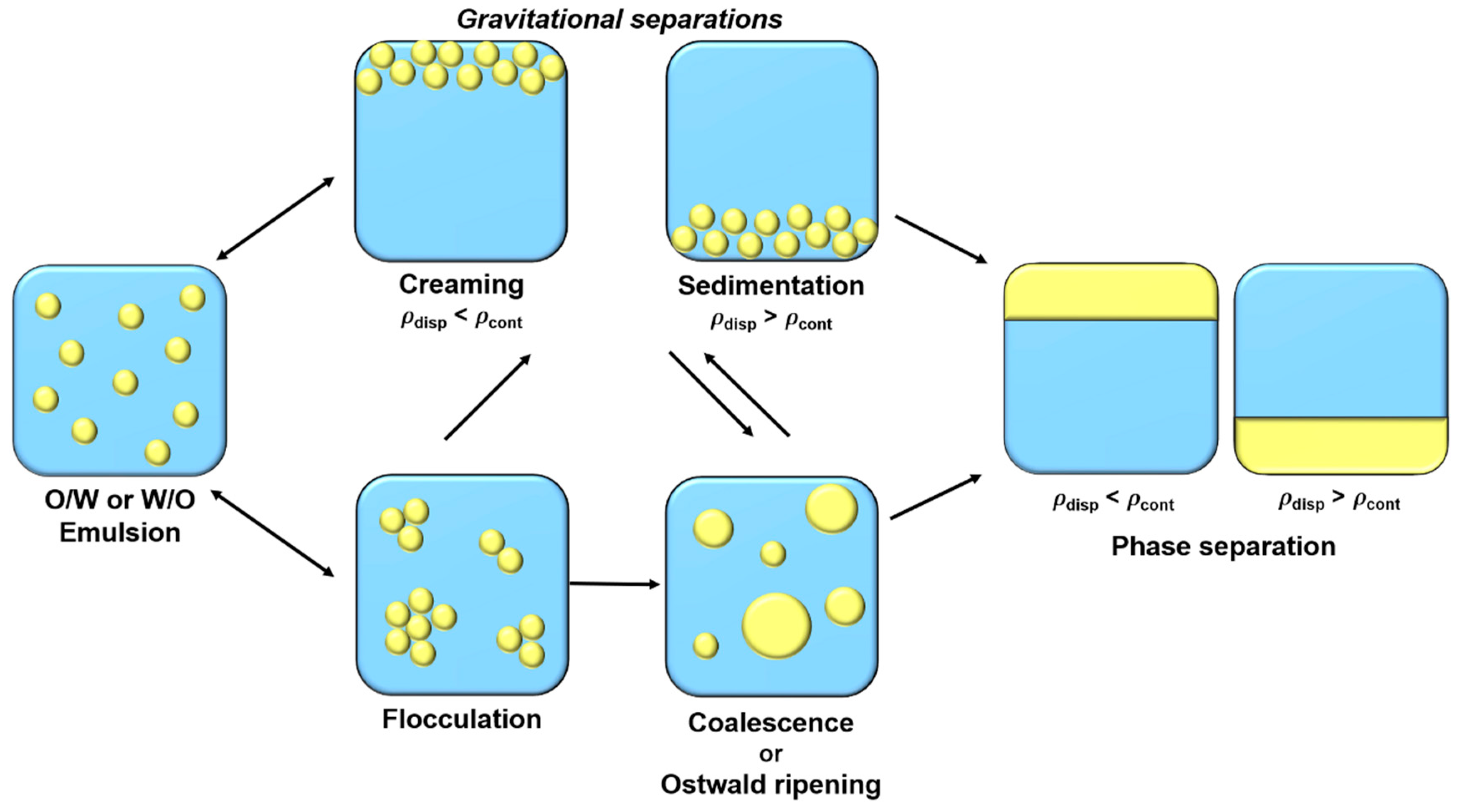

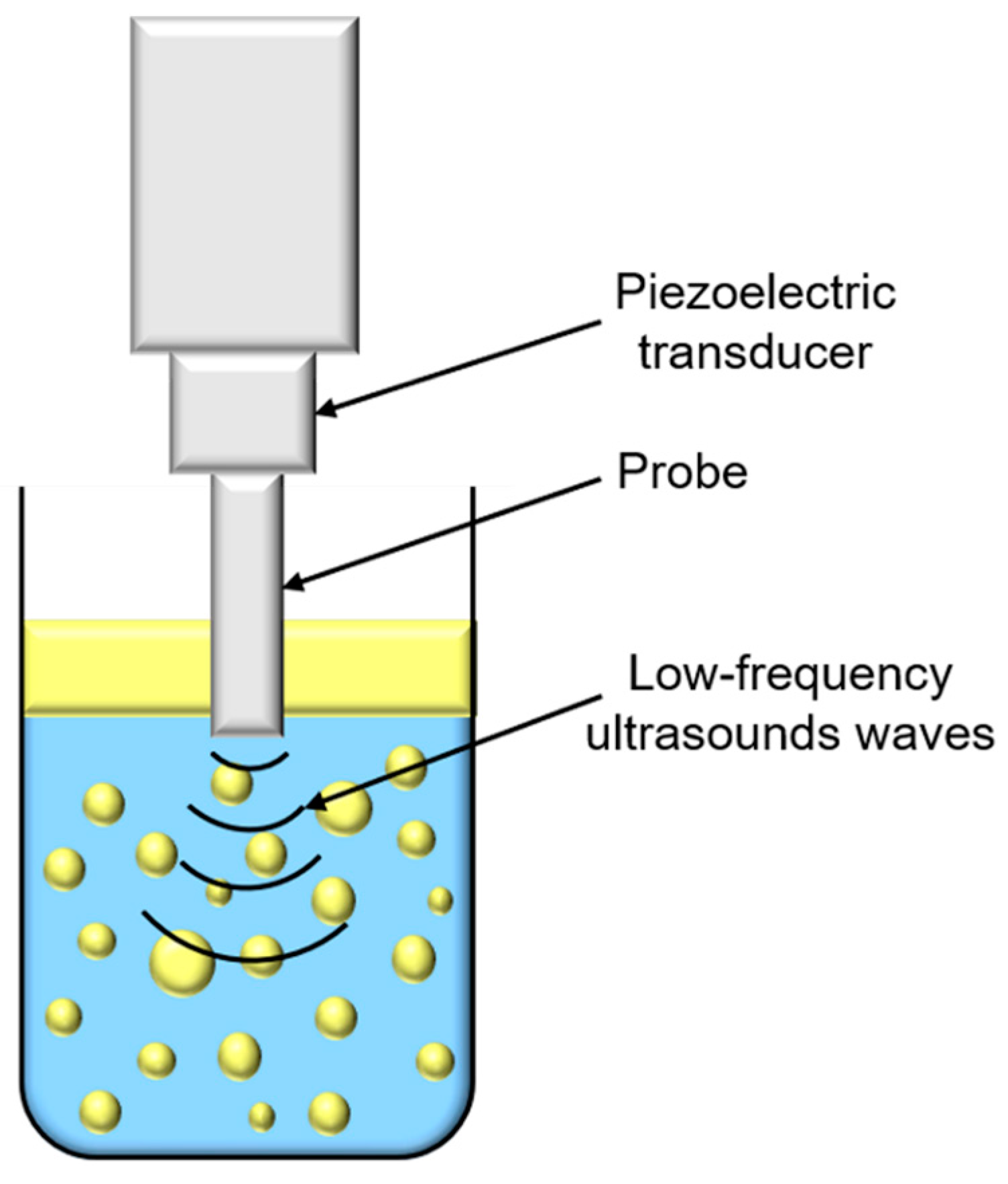
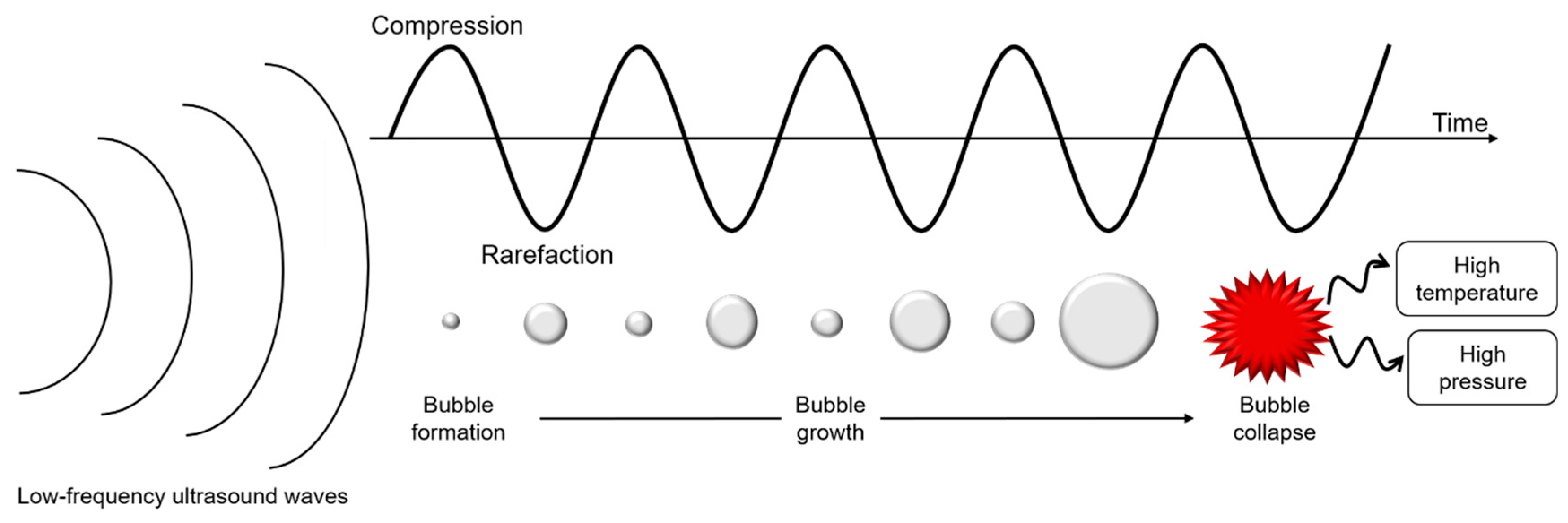

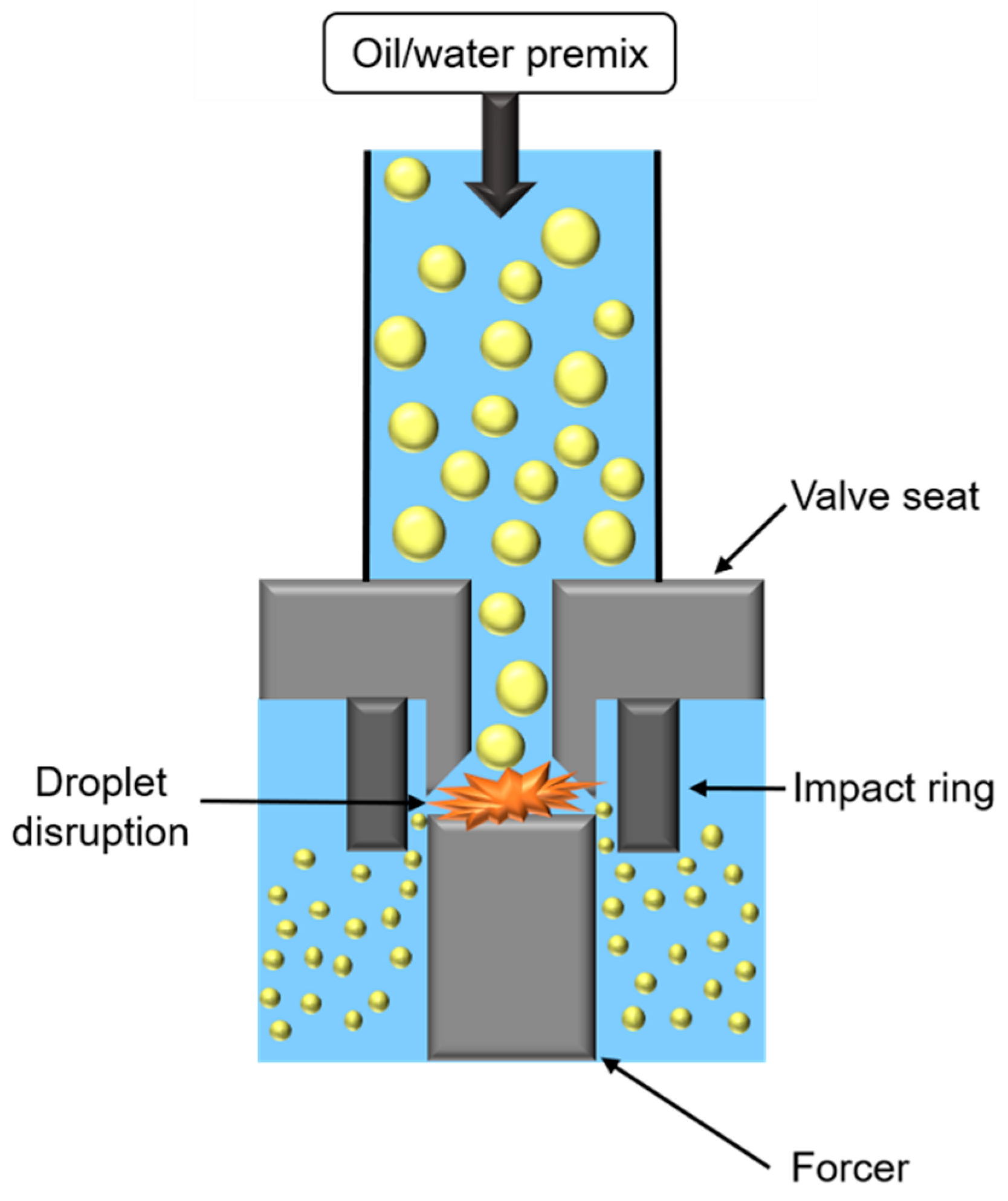
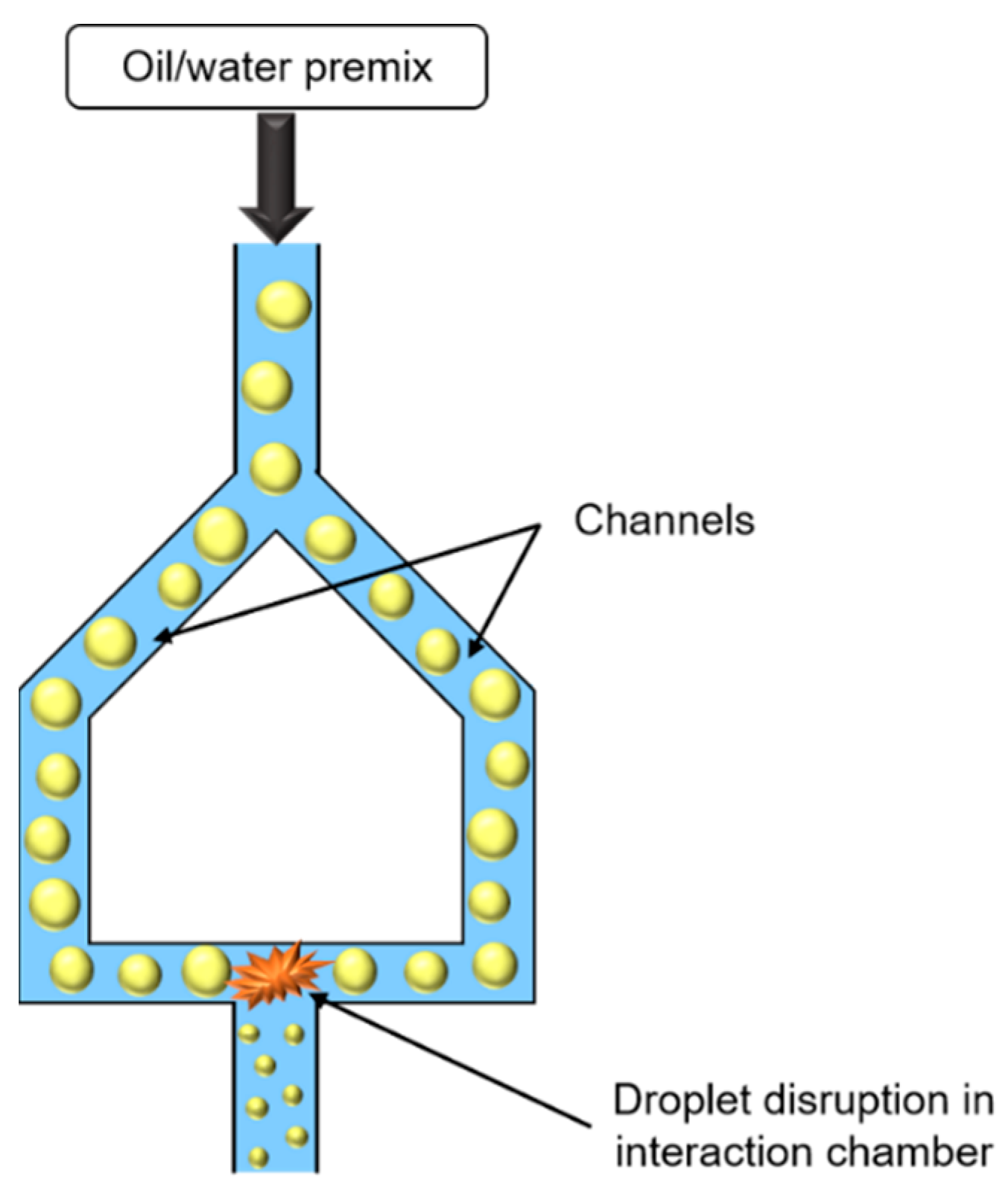
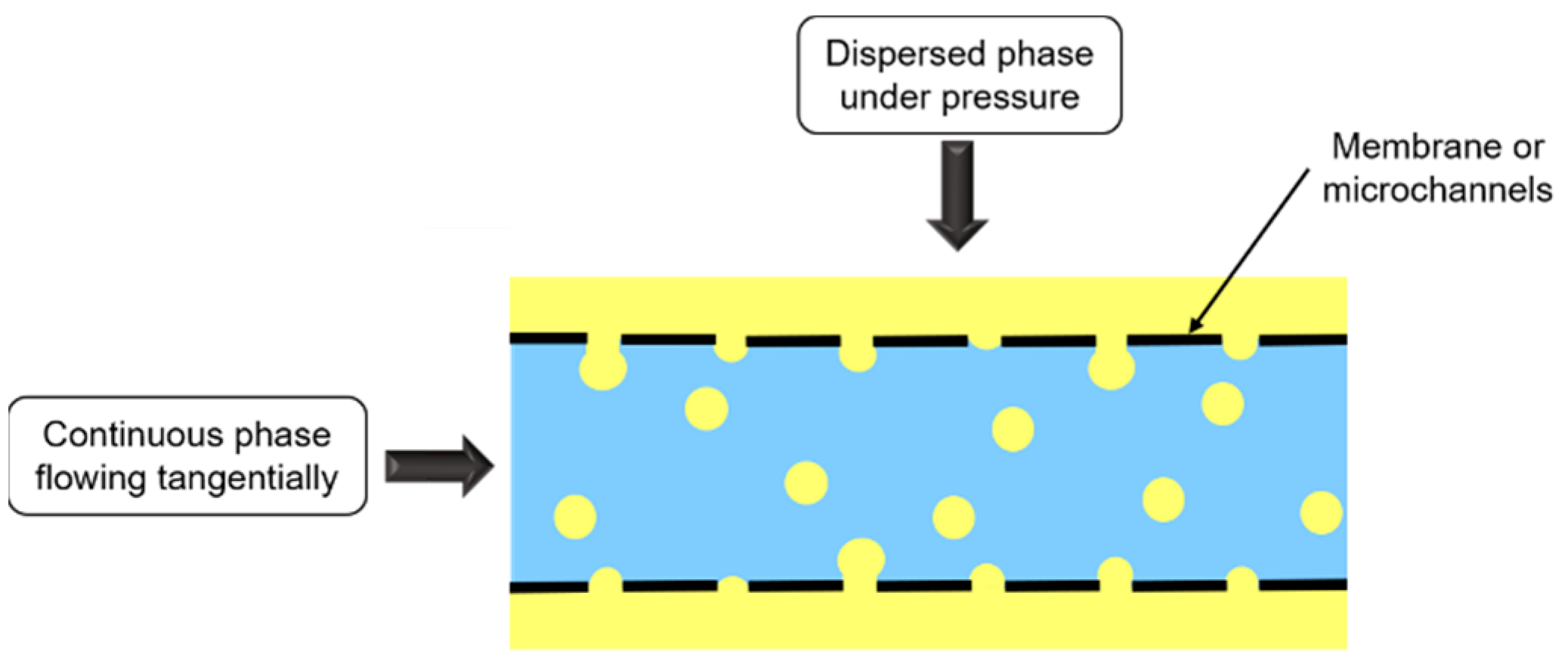


| Oil (Concentration) | Ultrasounds Frequencies (Treatment Time) | Mean Droplet Size (in nm) | References |
|---|---|---|---|
| Oleic acid (1.4% w/v) | 40 kHz (8 min) | 232 | [52] |
| 200 kHz (8 min) | ∼100 | ||
| 1 MHz (8 min) | ∼350 | ||
| 40 kHz (8 min) + 200 kHz (8 min) | ∼100 | ||
| 40 kHz (8 min) + 200 kHz (8 min) + 1 MHz (8 min) | 140 | ||
| 3,4-Ethylenedioxythiophene (0.3% w/v) | 20 kHz (5 min) | 351 | [19,53,54] |
| 20 kHz (5 min) + 1.6 MHz (5 min) | 208 | ||
| 20 kHz (5 min) + 1.6 MHz (5 min) + 2.4 MHz (5 min) | 82 | ||
| Oleic acid (Volume fraction: 8.0 × 10−4) | 20 kHz (1 min) | ∼100 | [55] |
| 20 kHz (1 min) + 0.5 MHz (3 min) | ∼90 | ||
| 20 kHz (1 min) + 0.5 MHz (3 min) + 1.6 MHz (3 min) | ∼70 | ||
| 20 kHz (1 min) + 0.5 MHz (3 min) + 1.6 MHz (3 min) + 2.4 MHz (3 min) | |||
| 20 kHz (1 min) + 0.5 MHZ (3 min) + 1.6 MHz (3 min) + 2.4 MHz (3 min) + 4.8 MHz (3 min) | |||
| Oleic acid (Volume fraction: 6.0 × 10−3) | ∼110 | ||
| Oleic acid (Volume fraction: 3.0 × 10−2) | ∼120 | ||
| Chloroform (Volume fraction: 2.0 × 10−2) | 20 kHz | 20,000 | |
| 20 kHz + 0.5 MHZ | <1000 | ||
| 20 kHz + 0.5 MHZ + 1.6 MHz + 2.4 MHz + 4.8 MHz | - | ||
| Methyl methacrylate | 20 kHz (8 min) | 220 | [56] |
| 20 kHz (8 min) + 500 kHz (10 min) | 112 | ||
| 20 kHz (8 min) + 500 kHz (10 min) + 1.6 MHz (10 min) | 51 | ||
| 20 kHz (8 min) + 500 kHz (10 min) + 1.6 MHz (10 min) + 2.4 MHz (10 min) | 23 | ||
| W/O emulsion: potassium carbonate (10% v/v) in chloroform | 20 kHz (10 min) + 1.6 MHz (10 min) + 2.4 MHz (10 min) | 436 | [57] |
| Two cycles: 20 kHz (10 min) + 1.6 MHz (10 min) + 2.4 MHz (10 min) | 112 | ||
| Methyl methacrylate | 20 kHz (5 min) | 103 | [58] |
| 20 kHz (5 min) + 500 kHz (10 min) | 87 | ||
| 20 kHz (5 min) + 500 kHz (10 min) + 1.6 MHz (10 min) | 61 | ||
| 20 kHz (5 min) + 500 kHz (10 min) + 1.6 MHz (10 min) + 2.4 MHz (10 min) | 42 | ||
| Perfluoromethyl-cyclohexane (2.4% v/v) | 20 kHz (7 min) | 175–311 | [59] |
| 20 kHz (7 min) + 500 kHz (15 min) | 224–430 | ||
| 20 kHz (7 min) + 500 kHz (15 min) + 1.6 MHz (15 min) | 342 | ||
| 20 kHz (7 min) + 500 kHz (15 min) + 1.6 MHz (15 min) + 2.4 MHz (15 min) | 306 | ||
| 20 kHz (7 min) + 500 kHz (15 min) + 1.6 MHz (15 min) + 2.4 MHz (15 min) + 5 MHz (15 min) | 158 | ||
| Allyltriethylsilane (3.75% w/v) | 20 kHz (5 min) | 1202 | [60] |
| 20 kHz (5 min) + 1.6 MHz (5 min) | 132 | ||
| 20 kHz (5 min) + 1.6 MHz (5 min) + 2.4 MHz (5 min) | 59 |
| Oil (Concentration) | Pre-Emulsification | Ultrasounds Frequencies and Treatment Time | Mean Droplet Size (in nm) | References |
|---|---|---|---|---|
| Sunflower oil (5; 10 and 15% v/v) | - | 1.7 MHz (10 h) | ∼1000 | [20] |
| Toluene (1% v/v)Emulsifier presence: Tween 20 (0.1% w/w) | Low-frequency ultrasounds (20 kHz, 4 min) or high-speed homogenizer (6000 rpm—10 min) or magnetic stirrer (1000 rpm—15 min) | Indirect irradiation (10 min) with 22.8 kHz; 127 kHz; 490 kHz; 1.64 MHz or 4.6 MHz | From 70 to 400 | [61] |
| Miglyol 812: Caprylic/capric triglycerides (10% v/v) | High-speed homogenization (5 min) | 1.7 MHz (1 h) | 220 | [62] |
| Sunflower oil (5% v/v) | High-speed homogenization (5 min) | 1.7 MHz (1 h) | 154 | [63] |
| Paraffin oil (8.2% w/w) + oleic acid (0.09% w/w) | High-speed homogenization (5 min) | 1.7 MHz (1 h) | 1920 | [64] |
| Interface Studied | Methods | Hypotheses | |||
|---|---|---|---|---|---|
| OH− Adsorption | H3O+ Adsorption | OH− and H3O+ Adsorption | Other Hypotheses | ||
| Oil/Water | Surface charge | [21,22,23,24,77,81,82,83,84] | - | [25,77] | [85,86] |
| Spectroscopy | [26,87] | - | [88,89] | [85,89,90,91] | |
| Simulation | - | - | - | [92,93] | |
| Surface tension | - | - | - | [94] | |
| Air/Water | Surface charge | [77,80,95,96] | - | [77,97,98] | - |
| Spectroscopy | [99,100,101] | [27,29,102,103,104,105] | [106] | [100] | |
| Simulation | [101,107,108,109,110,111,112] | [28,29,30,113,114,115,116,117] | [28,112,118,119,120,121] | [93,112,122] | |
| Surface tension | [108,109] | [30] | [120,123] | - | |
Publisher’s Note: MDPI stays neutral with regard to jurisdictional claims in published maps and institutional affiliations. |
© 2022 by the authors. Licensee MDPI, Basel, Switzerland. This article is an open access article distributed under the terms and conditions of the Creative Commons Attribution (CC BY) license (https://creativecommons.org/licenses/by/4.0/).
Share and Cite
Perrin, L.; Desobry-Banon, S.; Gillet, G.; Desobry, S. Review of High-Frequency Ultrasounds Emulsification Methods and Oil/Water Interfacial Organization in Absence of any Kind of Stabilizer. Foods 2022, 11, 2194. https://doi.org/10.3390/foods11152194
Perrin L, Desobry-Banon S, Gillet G, Desobry S. Review of High-Frequency Ultrasounds Emulsification Methods and Oil/Water Interfacial Organization in Absence of any Kind of Stabilizer. Foods. 2022; 11(15):2194. https://doi.org/10.3390/foods11152194
Chicago/Turabian StylePerrin, Louise, Sylvie Desobry-Banon, Guillaume Gillet, and Stephane Desobry. 2022. "Review of High-Frequency Ultrasounds Emulsification Methods and Oil/Water Interfacial Organization in Absence of any Kind of Stabilizer" Foods 11, no. 15: 2194. https://doi.org/10.3390/foods11152194
APA StylePerrin, L., Desobry-Banon, S., Gillet, G., & Desobry, S. (2022). Review of High-Frequency Ultrasounds Emulsification Methods and Oil/Water Interfacial Organization in Absence of any Kind of Stabilizer. Foods, 11(15), 2194. https://doi.org/10.3390/foods11152194






